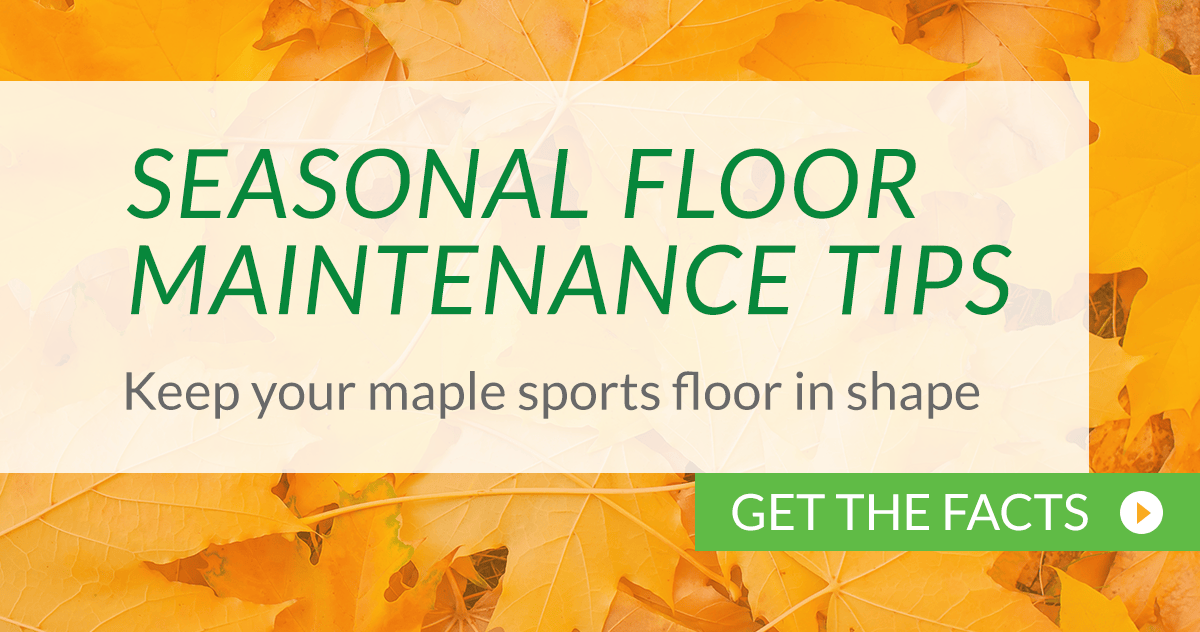Hardwood floors, like maple athletic surfaces, are built to withstand years of activity, traffic, and general wear and tear. However, at some point, even the most durable of surfaces will succumb to continual strain and frequent use and will need restoration.
There are many visible signs a hardwood floor is in need of a repair and are often the result of continual exposure to moisture. Damage may also occur below the surface and can be more difficult to detect until the problem has spread.
Below are some of the most common clues that it may be time to make some repairs to your facility’s flooring.
Your Flooring Has Begun to Buckle
One of the most visible signs that your facility’s flooring is in trouble is when the boards begin to buckle as a result of high relative humidity (RH) or moisture content (MC). This is one of the most extreme reactions to moisture/water in hardwood and occurs when the flooring expands, resulting in a variety of problems such as cupping, buckling, compression set of the flooring board edges, and structural failure of the floor system.
Various contributing factors can cause the wood to buckle, including changes in humidity, leaks in the roof, damaged fire sprinkler heads, and in severe cases, natural flooding.
Gaps Are Forming Between the Floor Boards
Gaps between the boards can occur as a result of a humidity imbalance in the area that causes the floorboards to shrink.
Minimal floorboard gaps and shifts occur naturally as a result of changing temperatures and humidity levels and don’t typically require repairs; however, large gaps resulting from excessively high RH levels can cause your surface to become hazardous for athletes, as the chance of tripping or losing balance is greatly increased.
Your Floor Shows Signs of Cupping or Crowning
Excessive changes in RH levels or moisture intrusion can cause damage to your maple floors. Cupping occurs when one side of the board gains or loses MC quicker than the other side. The expanding board edges can then begin to crush the adjoining boards as they expand, causing compression set and leading to gaps as the floor dries out.
Moisture imbalances can also damage the floor by crowning. This occurs when the top and bottom surfaces of the floor boards have different moisture levels. Crowning is often the result of prolonged exposure to moisture that remains on the floor surface. Its appearance differs from cupping in that it causes distortion in the center of the boards so that the middle of the floorboard is higher than the edges.
Ongoing Maintenance
Maple floors are designed to stand the test of time and continual wear and tear but can only maintain their quality with proper routine maintenance and repairs by professional athletic flooring contractors.
To prevent moisture damage to your maple surfaces, you should have your facility’s HVAC and plumbing systems carefully examined to prevent leaks and temperature-relative humidity damage to your flooring. It is best practice to have your facility’s HVAC and plumbing system inspected annually to address any concerns before they cause damage in surrounding areas.
To avoid major repairs, regular maintenance over the short- and long-term should be performed to preserve the quality of your facility’s floors and prevent injuries among users.
- Daily dust mopping helps to remove loose dirt and soil. Mats should be placed in doorways leading into gymnasiums and other sports surfaces to eliminate dirt and water from coming into contact with wood surfaces.
- For optimal athletic performance, hardwood surfaces should be screened and recoated yearly. Sanding the floor and applying new finish coats with new gamelines and graphics can rejuvenate and restore the floor’s beauty and luster.
- Refinishing should be done every 10 years to preserve the wood.
- Follow seasonal maintenance recommendations.

How Do You Know When It’s Time for a Replacement?
No matter what condition your maple flooring is in, there are some instances that simply go beyond repair. Some specialists may tell you if the damage (generally water-related) to a floor exceeds more than 50% of the area, it’s better to fully replace the flooring than to attempt a repair; however, there are other reasons for replacing a maple athletic floor system.
1. Your Floor Shows Obvious Signs of Aging
Properly installed flooring can handle decades of wear and tear, but like all natural materials, it has a life expectancy for delivering quality performance and will eventually be in need of a replacement.
Over time, after multiple sandings, hardwood floors may begin to show their age, especially if the floor has been in use for many decades. You’ll know it’s time start looking for a replacement when the boards begin to feel soft and bouncy.
Another sign your floor has reached its end is when nail heads begin to show and raise up from the surface of the floor, or when the wood begins to fracture or crack. These signs are more than cosmetic issues and could result in injury to athletes or others using the court.
2. Flooring No Longer Provides Optimal Athletic Performance
Replacing your maple sports floor is an investment of both time and money, but a properly installed sports surface can provide a quality athletic surface for a lifetime.
A loss of momentum when a ball is bounced, often referred to as a dead spot on basketball courts and gymnasiums, is a sign that it may be time to replace the athletic surface. These spots are typically the result of changes in the flooring’s humidity and moisture levels as well as continual expansion and contraction in areas of the flooring system.
Let Action Floors Help with Your Flooring Repairs and Replacements
Whether you’re repairing your maple sports floor or are looking to replace your entire surface, our trusted network of dealers can help with all your athletic flooring needs. To learn more about our products or to find a sales representative near you, contact us or give us a call at 1-800-746-3512 today!


















